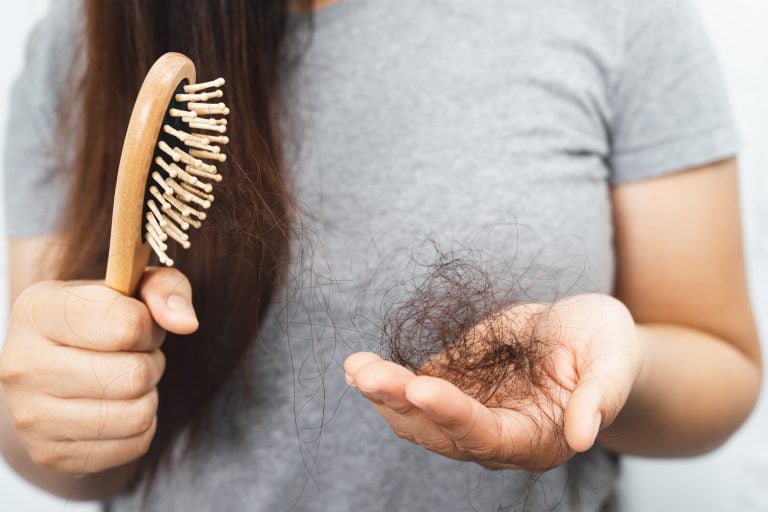Bacterial vaginosis (BV) is a common infection that occurs when the natural balance of vaginal bacteria is disrupted, typically by harmful organisms like Gardnerella vaginalis. Although some women experience mild or no symptoms, others notice a gray or white vaginal discharge with an unpleasant odor, along with itching and irritation. Left untreated, BV can lead to serious repercussions for fertility and reproductive health.1Kairys N, Carlson K, Garg M. Bacterial vaginosis. StatPearls. 2024; May 6. https://www.ncbi.nlm.nih.gov/books/NBK459216
Why vaginal pH matters
A healthy vagina has a moderately acidic pH between 3.8 and 5.0. Beneficial Lactobacilli bacteria support the vaginal microbiome by maintaining acidity and preventing bacterial overgrowth.2Lin Y, Chen W, Cheng C, Shen C. Vaginal pH value for clinical diagnosis and treatment of common vaginitis. Diagnostics. 2021;11(11). https://pmc.ncbi.nlm.nih.gov/articles/PMC8618584 When good bacteria are overrun, BV can take hold.
“[Untreated] BV can increase the risk of getting sexually transmitted infections (STIs), like chlamydia, gonorrhea, herpes, and HIV,” says Tori Hudson, ND, a gynecology professor and medical director at A Woman’s Time in Portland, Oregon. “If one has HIV, BV can increase the risk of passing it to their partner. BV can also cause pelvic inflammatory disease, which is an infection of the fallopian tubes and uterus that can lead to infertility and ectopic pregnancy.”
In pregnant women, untreated BV may lead to serious complications, including preterm labor, low birth weight, and spontaneous abortion. It can also raise the risk of infection following procedures like hysterectomy or dilation and curettage (D&C).
How to treat bacterial vaginosis
“The cornerstone of conventional treatment is to kill the overgrowth of bacteria using an oral or vaginal antibiotic,” says Dr. Hudson. “A naturopathic or integrative treatment approach works to restore healthy vaginal ecology and return the pH in the vagina to the normal acidic range.”
In some cases, vaginal antibiotics are preferred over oral ones. But antibiotics aren’t without downsides, as they disrupt beneficial bacterial species. This may lead to a high recurrence rate for BV and contribute to other infections.3Sousa L, Pereira SA, Cerca N. Fighting polymicrobial biofilms in bacterial vaginosis. Microb Biotechnol. 2023;16(7):1423-1437. https://pmc.ncbi.nlm.nih.gov/articles/PMC10281382
Natural remedies for BV

Probiotics are a front-line natural option. Studies show that both oral and vaginal probiotics not only help treat BV but also reduce the risk of it returning.4Webb L. Probiotics for preventing recurrent bacterial vaginosis. JAAPA. 2021;34(2):19-22. https://journals.lww.com/jaapa/fulltext/2021/02000/probiotics_for_preventing_recurrent_bacterial.2.aspx
“Vaginal specific lactobacillus species are used to restore vaginal ecology,” notes Dr. Hudson. “L. crispatus, L. rhamnosus, and L. reuteri are the most important species to consider.”
These beneficial bacteria, taken alongside prebiotics, can help relieve symptoms and prevent them from returning. Natural antimicrobials like tea tree oil, Berberis vulgaris, garlic, and apple cider vinegar may also reduce harmful bacteria that cause BV, address biofilms (a layer of bacteria that sticks to the inside of the vaginal wall), and lower the risk of reinfection.3Sousa L, Pereira SA, Cerca N. Fighting polymicrobial biofilms in bacterial vaginosis. Microb Biotechnol. 2023;16(7):1423-143,5Hameed S. Evaluating the antimicrobial efficacy of apple cider vinegar on bacteria and fungi isolated from vaginitis. KJPS. 2024;8(1). https://isnra.net/index.php/kjps/article/view/1126
“Boric acid suppositories are my most reliable vaginal medicine to use along with the vaginal-specific lactobacillus species because they help normalize vaginal pH,” says Dr. Hudson. “Not only do numerous studies demonstrate these suppositories [are] effective, but they are also safe in non-pregnant females and come with a high degree of patient satisfaction.”6Powell A, Ghanem KG, Rogers L, et al. Clinicians’ use of intravaginal boric acid maintenance therapy for recurrent vulvovaginal candidiasis and bacterial vaginosis. Sex Transm Dis. 2019;46(12):810-812. https://doi.org/10.1097/OLQ.0000000000001063
Ways to prevent BV
Avoid vaginal douching, as it can disrupt delicate bacterial balance and raise the risk of BV, STIs, pelvic inflammatory disease, and more.7Ness RB, Hillier SL, Kip KE, et al. Douching, pelvic inflammatory disease, and incident gonococcal and chlamydial genital infection in a cohort of high-risk women. Am J Epidemiol. 2005 Jan 15;161(2):186-95. https://doi.org/10.1093/aje/kwi025 Also steer clear of scented vaginal products, which often contain harmful chemicals and may affect pH in the vagina.
Other risk factors include having multiple sexual partners and using copper IUDs like Paragard, both of which are associated with a higher chance of developing BV.8Madden T, Grentzer JM, Secura GM, Allsworth JE, Peipert JF. Risk of bacterial vaginosis in users of the intrauterine device: a longitudinal study. Sex Transm Dis. 2012 Mar;39(3):217-22. https://doi.org/10.1097/OLQ.0b013e31823e68fe
A two-part strategy for vaginal health
Antibiotics can be quick and effective and are sometimes necessary to treat BV. But they don’t address the root of the problem, which is often an imbalanced vaginal microbiome. The most effective course may combine strategies to reduce harmful bacteria with efforts to restore healthy vaginal ecology.
A natural treatment plan works by doing just that: rebalancing vaginal bacteria and restoring normal pH. This comprehensive approach not only relieves symptoms but also helps prevent BV from coming back.
Footnotes
- 1Kairys N, Carlson K, Garg M. Bacterial vaginosis. StatPearls. 2024; May 6. https://www.ncbi.nlm.nih.gov/books/NBK459216
- 2Lin Y, Chen W, Cheng C, Shen C. Vaginal pH value for clinical diagnosis and treatment of common vaginitis. Diagnostics. 2021;11(11). https://pmc.ncbi.nlm.nih.gov/articles/PMC8618584
- 3Sousa L, Pereira SA, Cerca N. Fighting polymicrobial biofilms in bacterial vaginosis. Microb Biotechnol. 2023;16(7):1423-143
- 4Webb L. Probiotics for preventing recurrent bacterial vaginosis. JAAPA. 2021;34(2):19-22. https://journals.lww.com/jaapa/fulltext/2021/02000/probiotics_for_preventing_recurrent_bacterial.2.aspx
- 5Hameed S. Evaluating the antimicrobial efficacy of apple cider vinegar on bacteria and fungi isolated from vaginitis. KJPS. 2024;8(1). https://isnra.net/index.php/kjps/article/view/1126
- 6Powell A, Ghanem KG, Rogers L, et al. Clinicians’ use of intravaginal boric acid maintenance therapy for recurrent vulvovaginal candidiasis and bacterial vaginosis. Sex Transm Dis. 2019;46(12):810-812. https://doi.org/10.1097/OLQ.0000000000001063
- 7Ness RB, Hillier SL, Kip KE, et al. Douching, pelvic inflammatory disease, and incident gonococcal and chlamydial genital infection in a cohort of high-risk women. Am J Epidemiol. 2005 Jan 15;161(2):186-95. https://doi.org/10.1093/aje/kwi025
- 8Madden T, Grentzer JM, Secura GM, Allsworth JE, Peipert JF. Risk of bacterial vaginosis in users of the intrauterine device: a longitudinal study. Sex Transm Dis. 2012 Mar;39(3):217-22. https://doi.org/10.1097/OLQ.0b013e31823e68fe





